FujiFilm X-E1 User Manual
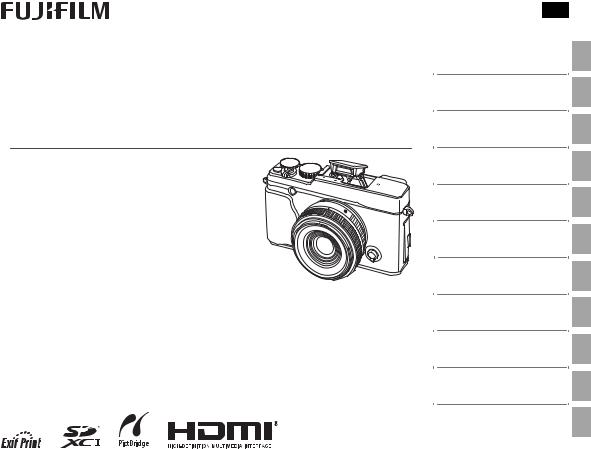
DIGITAL CAMERA
X-E1
Owner’s Manual
Thank you for your purchase of this product. This manual describes how to use your FUJIFILM X-E1 digital camera and install the supplied software. Be sure that you have read and understood its contents before using the camera.
For information on related products, visit our website at
http://www.fujifilm.com/products/digital_cameras/index.html
For more information on the X-E1, visit
http://fujifilm-x.com/x-e1/
BL01756-200 EN
Before You Begin
First Steps
Basic Photography
and Playback
Basic Movie Recording
and Playback
The Q (Quick Menu) Button
More on Photography and Playback
Menus
Connections
Technical Notes
Troubleshooting
Appendix
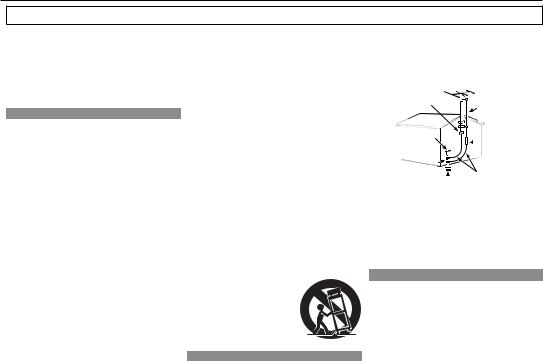
 For Your Safety
For Your Safety
IMPORTANT SAFETY INSTRUCTIONS
•Read Instructions: All the safety and operating instructions should be read before the appliance is operated.
•Retain Instructions: The safety and operating instructions should be retained for future reference.
•Heed Warnings: All warnings on the appliance and in the operating instructions should be adhered to.
•Follow Instructions: All operating and use instructions should be followed.
Installation
Power Sources: This video product should be operated only from the type of power source indicated on the marking label. If you are not sure of the type of power supply to your home, consult your appliance dealer or local power company. For video products intended to operate from battery power, or other sources, refer to the operating instructions.
Grounding or Polarization: This video product is equipped with a polarized alternating-current line plug (a plug having one blade wider than the other). This plug will fi t into the power outlet only one way. This is a safety feature. If you are unable to insert the plug fully into the outlet, try reversing the plug. If the plug should still fail to fi t, contact your electrician to replace your obsolete outlet. Do not defeat the safety purpose of the polarized plug.
Alternate Warnings: This video product is equipped with a three-wire grounding-type plug, a plug having a third (grounding) pin. This plug will only fi t into a groundingtype power outlet. This is a safety feature. If you are unable to insert the plug into the outlet, contact your electrician to replace your obsolete outlet. Do not defeat the safety purpose of the grounding type plug.
Overloading: Do not overload wall outlets and extension cords as this can result in a risk of fi re or electric shock.
Ventilation: Slots and openings in the cabinet are provided for ventilation, to ensure reliable operation of the video product and to protect it from overheating, and these openings must not be blocked or covered. The openings should never be blocked by placing the video product on a bed, sofa, rug, or other similar surface.
This video product should not be placed in a built-in installation such as a bookcase or rack unless proper ventilation is provided or the manufacturer’s instructions have been adhered to. This video product should never be placed near or over a radiator or heat register.
Attachments: Do not use attachments not recommended by the video product manufacturer as they may cause hazards.
Water and Moisture: Do not use this video product near wa- ter—for example, near a bath tub, wash bowl, kitchen sink, or laundry tub, in a wet basement, or near a swimming pool, and the like.
Power-Cord Protection: Power-supply cords should be routed so that they are not likely to be walked on or pinched by items placed upon or against them, paying particular attention to cords at plugs, convenience receptacles, and the point where they exit from the appliance.
Accessories: Do not place this video product on an unstable cart, stand, tripod, bracket, or table. The video product may fall, causing serious injury to a child or adult, and serious damage to the appliance. Use only with a cart, stand, tripod, bracket, or table recommended by the manufacturer, or sold with the video product. Any mounting of the appliance should follow the manufacturer’s instructions, and should use a mounting accessory recommended by the manufacturer.
An appliance and cart combination should be moved with care. Quick stops, excessive force, and uneven surfaces may cause the appliance and cart combination to overturn.
Antennas
Outdoor Antenna Grounding: If an outside antenna or cable system is connected to the video product, be sure the antenna or cable system is grounded so as to provide some protection against voltage surges and built-up static charges. Section 810 of the National Electrical Code, ANSI/NFPA No. 70, provides information with respect to proper grounding of the
mast and supporting structure, grounding of the lead-in wire to an antenna discharge unit, size of grounding conductors, location of antenna discharge unit, connection to grounding electrodes, and requirements for the grounding electrode.
EXAMPLE OF ANTENNA GROUNDING
AS PER NATIONAL ELECTRICAL CODE
Ground Clamp |
|
Antenna Lead |
||
|
|
|
in Wire |
|
Electric Service |
|
Antenna |
||
Equipment |
|
Discharge Unit |
||
|
|
|
(NEC SECTION |
|
|
|
|
||
|
|
810-20) |
||
Ground Clamps |
|
Grounding Conductors |
||
|
|
|
||
|
|
|
(NEC SECTION 810-21) |
|
Power Service Grounding Electrode |
||||
|
|
|||
System (NEC ART 250. PART H) |
|
|
||
Power Lines: An outside antenna system should not be located in the vicinity of overhead power lines or other electric light or power circuits, or where it can fall into such power lines or circuits. When installing an outside antenna system, extreme care should be taken to keep from touching such power lines or circuits as contact with them might be fatal.
Use
Cleaning: Unplug this video product from the wall outlet before cleaning. Do not use liquid cleaners or aerosol cleaners. Use a damp cloth for cleaning.
Object and Liquid Entry: Never push objects of any kind into this video product through openings as they may touch dangerous voltage points or short out parts that could result in a fi re or electric shock. Never spill liquid of any kind on the video product.
Lightning: For added protection for this video product receiver during a lightning storm, or when it is left unattended and unused for long periods of time, unplug it from the wall outlet and disconnect the antenna or cable system. This will prevent damage to the video product due to lightning and power-line surges.
ii
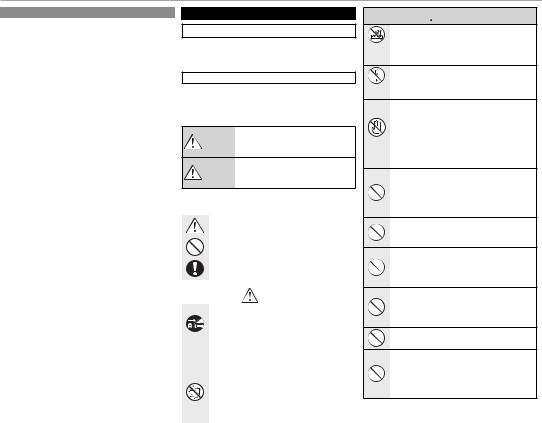
For Your Safety
Service
Servicing: Do not attempt to service this video product yourself as opening or removing covers may expose you to dangerous voltage or other hazards. Refer all servicing to qualifi ed service personnel.
Damage Requiring Service: Unplug this video product from the wall outlet and refer servicing to qualifi ed service personnel under the following conditions:
•When the power-supply cord or plug is damaged
•If liquid has been spilled, or objects have fallen into the video product.
•If the video product has been exposed to rain or water.
•If the video product has been dropped or the cabinet has been damaged.
If the video product does not operate normally follow the operating instructions. Adjust only those controls that are covered by the operating instructions as an improper adjustment of other controls may result in damage and will often require extensive work by a qualifi ed technician to restore the video product to its normal operation.
When the video product exhibits a distinct change in performance — this indicates a need for service.
Replacement Parts: When replacement parts are required, be sure the service technician has used replacement parts specifi ed by the manufacturer or have the same characteristics as the original part. Unauthorized substitutions may result in fi re, electric shock or other hazards.
Safety Check: Upon completion of any service or repairs to this video product, ask the service technician to perform safety checks to determine that the video product is in proper operating condition.
Be sure to read these notes before use
Safety Notes
•Make sure that you use your camera correctly. Read these safety notes and your Owner’s Manual carefully before use.
•After reading these safety notes, store them in a safe place.
About the Icons
The icons shown below are used in this document to indicate the severity of the injury or damage that can result if the information indicated by the icon is ignored and the product is used incorrectly as a result.
This icon indicates that death or seri- WARNING ous injury can result if the information
is ignored.
This icon indicates that personal injury CAUTION or material damage can result if the in-
formation is ignored.
The icons shown below are used to indicate the nature of the instructions which are to be observed.
|
Triangular icons tell you that this information re- |
|
|
quires attention (“Important”). |
|
|
Circular icons with a diagonal bar tell you that the |
|
|
action indicated is prohibited (“Prohibited”). |
|
|
|
|
|
Filled circles with an exclamation mark indicate an |
|
|
action that must be performed (“Required”). |
|
|
|
|
|
|
|
|
WARNING |
|
|
If a problem arises, turn the camera off, remove the |
|
|
battery, and disconnect and unplug the AC power |
|
|
adapter. Continued use of the camera when it |
|
Unplug |
is emitting smoke, is emitting any unusual odor, |
|
from power |
or is in any other abnormal state can cause a fi re |
|
socket |
||
|
or electric shock. Contact your FUJIFILM dealer. |
|
|
Do not allow water or foreign objects to enter the |
|
|
camera. If water or foreign objects get inside the |
|
|
camera, turn the camera o , remove the battery, |
|
|
and disconnect and unplug the AC power adapt- |
|
|
er. Continued use of the camera can cause a fi re |
|
|
or electric shock. Contact your FUJIFILM dealer. |
|
 WARNING
WARNING
Do not use the camera in the bathroom or shower.
Do not use in This can cause a fi re or electric shock. the bathroom
or shower
|
|
|
Never attempt to change or take apart the camera |
|
|
|
|
(never open the case). Failure to observe this pre- |
|
Do not disas- |
||||
caution can cause fi re or electric shock. |
||||
semble |
|
|||
Should the case break open as the result of a fall or other accident, do not touch the exposed parts. Failure to observe this precaution could result in electric shock or in injury from touching the damaged
Do not touch parts. Remove the battery immediately, taking internal parts
care to avoid injury or electric shock, and take the product to the point of purchase for consultation.
Do not change, heat or unduly twist or pull the connection cord and do not place heavy objects on the connection cord. These actions could damage the cord and cause a fi re or electric shock. If the cord is damaged, contact your FUJIFILM dealer.
Do not place the camera on an unstable surface. This can cause the camera to fall or tip over and cause injury.
Never attempt to take pictures while in motion. Do not use the camera while walking or driving. This can result in you falling down or being involved in a tra c accident.
Do not touch any metal parts of the camera during a thunderstorm. This can cause an electric shock due to induced current from the lightning discharge.
Do not use the battery except as specified. Load the battery as shown by the indicator.
Do not heat, change or take apart the battery. Do not drop or subject the battery to impacts. Do not store the battery with metallic products. Any of these actions can cause the battery to burst or leak and cause fi re or injury as a result.
iii
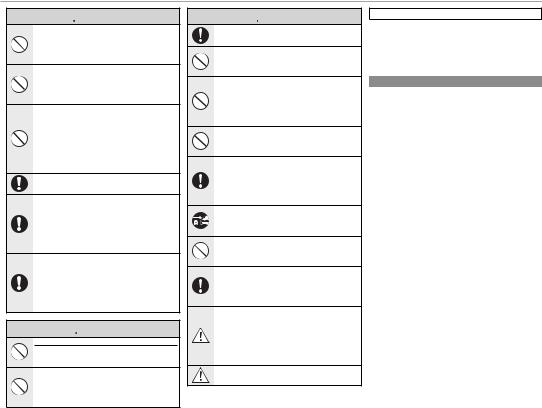
For Your Safety
 WARNING
WARNING
Use only batteries or AC power adapters specified for use with this camera. Do not use voltages other than the power supply voltage shown. The use of other power sources can cause a fi re.
If the battery leaks and fluid gets in contact with your eyes, skin or clothing, flush the affected area with clean water and seek medical attention or call an emergency number right away.
Do not use the charger to charge batteries other than those specified here. The supplied charger is for use only with batteries of the type supplied with the camera. Using the charger to charge conventional batteries or other types of rechargeable batteries can cause the battery to leak, overheat or burst.
Do not use in the presence of flammable objects, explosive gases, or dust.
When carrying the battery, install it in a digital camera or keep it in the hard case. When storing the battery, keep it in the hard case. When discarding, cover the battery terminals with insulation tape. Contact with other metallic objects or batteries could cause the battery to ignite or burst.
Keep memory cards out of the reach of small children.
Because memory cards are small, they can be swallowed by children. Be sure to store memory cards out of the reach of small children. If a child swallows a memory card, seek medical attention or call an emergency number.
 CAUTION
CAUTION
Do not use this camera in locations affected by oil fumes, steam, humidity or dust. This can cause a
fi re or electric shock.
Do not leave this camera in places subject to extremely high temperatures. Do not leave the camera in locations such as a sealed vehicle or in direct sunlight. This can cause a fi re.
 CAUTION
CAUTION
Keep out of the reach of small children. This product could cause injury in the hands of a child.
Do not place heavy objects on the camera. This can cause the heavy object to tip over or fall and cause injury.
Do not move the camera while the AC power adapter is still connected. Do not pull on the connection cord to disconnect the AC power adapter. This can damage the power cord or cables and cause a fi re or electric shock.
Do not cover or wrap the camera or the AC power adapter in a cloth or blanket. This can cause heat to build up and distort the casing or cause a fi re.
When you are cleaning the camera or you do not plan to use the camera for an extended period, remove the battery and disconnect and unplug the AC power adapter. Failure to do so can cause a fi re or electric shock.
When charging ends, unplug the charger from the power socket. Leaving the charger plugged into the power socket can cause a fi re.
Using a flash too close to a person’s eyes may temporarily affect the eyesight. Take particular care when photographing infants and young children.
When a memory card is removed, the card could come out of the slot too quickly. Use your finger to hold it and gently release the card. Injury could result to those struck by the ejected card.
Request regular internal testing and cleaning for your camera. Build-up of dust in your camera can cause a fi re or electric shock. Contact your FUJIFILM dealer to request internal cleaning every two years. Please note that this service is not free of charge.
Danger of explosion if battery is incorrectly replaced. Replace only with the same or equivalent type.
The Battery and Power Supply
Note: Check the type of battery used in your camera and read the appropriate sections.
The following describes the proper use of batteries and how to prolong their life. Incorrect use can shorten battery life or cause leakage, overheating, fi re, or explosion.
Li-ion Batteries
Read this section if your camera uses a rechargeable Li-ion battery.
The battery is not charged at shipment. Charge the battery before use. Keep the battery in its case when not in use.
■ Notes on the Battery
The battery gradually loses its charge when not in use. Charge the battery one or two days before use.
Battery life can be extended by turning the camera o when not in use.
Battery capacity decreases at low temperatures; a depleted battery may not function at when cold. Keep a fully charged spare battery in a warm place and exchange as necessary, or keep the battery in your pocket or other warm place and insert it in the camera only when shooting. Do not place the battery in direct contact with hand warmers or other heating devices.
■ Charging the Battery
Charge the battery in the supplied battery charger. Charging times will increase at ambient temperatures below +10 °C (+50 °F) or above +35 °C (+95 °F). Do not attempt to charge the battery at temperatures above 40 °C (+104 °F); at temperatures below 0 °C (+32 °F), the battery will not charge.
Do not attempt to recharge a fully charged battery. The battery does not however need to be fully discharged before charging.
The battery may be warm to the touch immediately after charging or use. This is normal.
iv

For Your Safety
■ Battery Life
At normal temperatures, the battery can be recharged about 300 times. A noticeable decrease in the length of time the battery will hold a charge indicates that it has reached the end of its service life and should be replaced.
■ Storage
Performance may be impaired if the battery is left unused for extended periods when fully charged. Run the battery fl at before storing it.
If the camera will not be used for an extended period, remove the battery and store it in a dry place with an ambient temperature of from +15 °C to +25 °C (+59 °F to +77 °F). Do not store in locations exposed to extremes of temperature.
■ Cautions: Handling the Battery
•Do not transport or store with metal objects such as necklaces or hairpins.
•Do not expose to fl ame or heat.
•Do not disassemble or modify.
•Use with designated chargers only.
•Dispose of used batteries promptly.
•Do not drop or subject to strong physical shocks.
•Do not expose to water.
•Keep the terminals clean.
•The battery and camera body may become warm to the touch after extended use. This is normal.
AAAlkaline/Rechargeable Ni-MH Batteries
Read this section if your camera uses AA alkaline or rechargeable AA Ni-MH batteries. Information on compatible battery types may be found elsewhere in the camera manual.
■ Cautions: Handling the Batteries
•Do not expose to water, fl ame, or heat, or store in warm or humid conditions.
•Do not transport or store with metal objects such as necklaces or hairpins.
•Do not disassemble or modify the batteries or battery casing.
•Do not subject to strong physical shocks.
•Do not use batteries that are leaking, deformed, or discolored.
•Keep out of reach of infants and small children.
•Insert in the correct orientation.
•Do not mix old and new batteries, batteries with di erent charge levels, or batteries of di erent types.
•If the camera will not be used for an extended period, remove the batteries. Note that the camera clock will be reset.
•The batteries may be warm to the touch immediately after use. Turn the camera o and allow the batteries to cool before handling.
•Battery capacity tends to decrease at low temperatures. Keep spare batteries in a pocket or other warm place and exchange as necessary. Cold batteries may recover some of their charge when warmed.
•Fingerprints and other stains on the battery terminals can impair battery performance. Thoroughly clean the terminals with a soft, dry cloth before inserting them in the camera.
If the batteries leak, clean the battery compartment thoroughly before inserting new batteries.
If fl uid from the battery comes into contact with skin or clothing, fl ush the a ected area with water. If fluid enters your eyes, immediately flush the affected
area with water and seek medical attention. Do not rub your eyes. Failure to observe this precaution could result in permanent visual impairment.
■ Ni-MH Batteries
The capacity of Ni-MH batteries may be temporarily reduced when new, after long periods of disuse, or if they are repeatedly recharged before being fully discharged. This is normal and does not indicate a malfunction. Capacity can be increased by repeatedly discharging the batteries using the discharge option in the camera setup menu and recharging them using a battery charger.
QCAUTION: Do not use the discharge option with alkaline batteries.
The camera draws a small amount of current even when o . Ni-MH batteries that have been left in the camera for an extended period may be drawn down to the point that they no longer hold a charge. Battery performance may also drop if the batteries are run down in a device such as a fl ashlight. Use the discharge option in the camera setup menu to discharge Ni-MH batteries. Batteries that no longer hold a charge even after repeatedly being discharged and recharged have reached the end of their service life and must be replaced.
Ni-MH batteries can be recharged in a battery charger (sold separately). Batteries may become warm to the touch after charging. Refer to the instructions provided with the charger for more information. Use the charger with compatible batteries only.
Ni-MH batteries gradually lose their charge when not in use.
■ Disposal
Dispose of used batteries in accord with local regulations.
AC Power Adapters (Available Separately)
This section applies to all camera models. Use only FUJIFILM AC power adapters designated for use with this camera. Other adapters could damage the camera.
•The AC power adapter is for indoor use only.
•Be sure the DC plug is securely connected to the camera.
•Turn the camera o before disconnecting the adapter. Disconnect the adapter by the plug, not the cable.
•Do not use with other devices.
•Do not disassemble.
•Do not expose to high heat and humidity.
•Do not subject to strong physical shocks.
•The adapter may hum or become hot to the touch during use. This is normal.
•If the adapter causes radio interference, reorient or relocate the receiving antenna.
v

For Your Safety
Using the Camera
•Do not aim the camera at extremely bright light sources, such as the sun in a cloudless sky. Failure to observe this precaution could damage the camera image sensor.
•Strong sunlight focused through the viewfi nder may damage the panel of electronic viewfi nder (EVF). Do not aim the electronic viewfi nder at the sun.
Take Test Shots
Before taking photographs on important occasions (such as at weddings or before taking the camera on a trip), take a test shot and view the results to ensure that the camera is functioning normally. FUJIFILM Corporation can not accept liability for damages or lost profi ts incurred as a result of product malfunction.
Notes on Copyright
Unless intended solely for personal use, images recorded using your digital camera system cannot be used in ways that infringe copyright laws without the consent of the owner. Note that some restrictions apply to the photographing of stage performances, entertainments, and exhibits, even when intended purely for personal use. Users are also asked to note that the transfer of memory cards containing images or data protected under copyright laws is only permissible within the restrictions imposed by those copyright laws.
Handling
To ensure that images are recorded correctly, do not subject the camera to impact or physical shocks while images are being recorded.
Liquid Crystal
In the event that the display is damaged, care should be taken to avoid contact with liquid crystal. Take the urgent action indicated should any of the following situations arise:
•If liquid crystal comes in contact with your skin, clean the area with a cloth and then wash thoroughly with soap and running water.
•If liquid crystal enters your eyes, fl ush the a ected eye with clean water for at least 15 minutes and then seek medical assistance.
•If liquid crystal is swallowed, rinse your mouth thoroughly with water. Drink large quantities of water and induce vomiting, then seek medical assistance.
Although the display is manufactured using extremely highprecision technology, it may contain pixels that are always lit or that do not light. This is not a malfunction, and images recorded with the product are una ected.
Trademark Information
xD-Picture Card and E are trademarks of FUJIFILM Corporation. The typefaces included herein are solely developed by DynaComware Taiwan Inc. Macintosh, QuickTime, and Mac OS are trademarks of Apple Inc. in the U.S.A. and other countries. Windows 7, Windows Vista, and the Windows logo are trademarks of the Microsoft group of companies. Adobe and Adobe Reader are either trademarks or registered trademarks of Adobe Systems Incorporated in the U.S.A. and/or other countries. The SDHC and SDXC logos are trademarks of SD-3C, LLC. The HDMI logo is a trademark. YouTube is a trademark of Google Inc. All other trade names mentioned in this manual are the trademarks or registered trademarks of their respective owners.
Electrical Interference
This camera may interfere with hospital or aviation equipment. Consult with hospital or airline sta before using the camera in a hospital or on an aircraft.
Color Television Systems
NTSC (National Television System Committee) is a color television telecasting specifi cation adopted mainly in the U.S.A., Canada, and Japan. PAL (Phase Alternation by Line) is a color television system adopted mainly in European countries and China.
Electrical Interference
Exif Print is a newly revised digital camera fi le format in which information stored with photographs is used for optimal color reproduction during printing.
IMPORTANT NOTICE: Read Before Using the Software
Direct or indirect export, in whole or in part, of licensed software without the permission of the applicable governing bodies is prohibited.
vi

For Your Safety
NOTICES
To prevent fire or shock hazard, do not expose the unit to rain or moisture.
Please read the “Safety Notes” and make sure you understand them before using the camera.
Perchlorate Material—special handling may apply. See http://www.dtsc.ca.gov/ hazardouswaste/perchlorate.
For Customers in the U. S. A.
Tested To Comply With FCC Standards
FOR HOME OR OFFICE USE
FCC Statement: This device complies with Part 15 of the FCC Rules. Operation is subject to the following two conditions: (1) This device may not cause harmful interference, and (2) this device must accept any interference received, including interference that may cause undesired operation.
CAUTION: This equipment has been tested and found to comply with the limits for a Class B digital device, pursuant to Part 15 of the FCC Rules. These limits are designed to provide reasonable protection against harmful interference in a residential installation. This equipment generates, uses, and can radiate radio frequency energy and, if not installed and used in accordance with the instructions, may cause harmful interference to radio communications. However, there is no guarantee that interference will not occur in a particular installation. If this equipment does cause harmful interference to radio or television reception, which can be determined by turning the equipment o and on, the user is encouraged to try to correct the interference by one or more of the following measures:
•Reorient or relocate the receiving antenna.
•Increase the separation between the equipment and receiver.
•Connect the equipment into an outlet on a circuit di erent from that to which the receiver is connected.
•Consult the dealer or an experienced radio/TV technician for help.
•You are cautioned that any changes or modifi cations not expressly approved in this manual could void the user’s authority to operate the equipment.
Notes on the Grant: To comply with Part 15 of the FCC Rules, this product must be used with a Fujifi lm-specifi ed ferrite-core A/V cable, USB cable, and DC supply cord.
For Customers in Canada
CAUTION: This Class B digital apparatus complies with Canadian ICES-003.
Disposal of Electrical and Electronic Equipment in Private Households
In the European Union, Norway, Iceland and Liechtenstein: This symbol on the product, or in the manual and in the warranty, and/or on its packaging indicates that this product shall not be treated as household waste. Instead it should be taken to an applicable collection point for the recycling of electrical and electronic equipment.
By ensuring this product is disposed of correctly, you will help prevent potential negative consequences to the environment and human health, which could otherwise be caused by inappropriate waste handling of this product.
This symbol on the batteries or accumulators indicates that those batteries shall not be treated as household waste.
If your equipment contains easy removable batteries or accumulators please dispose these separately according to your local requirements.
The recycling of materials will help to conserve natural resources. For more detailed information about recycling this product, please contact your local city o ce, your household waste disposal service or the shop where you purchased the product.
In Countries Outside the European Union, Norway, Iceland and Liechtenstein: If you wish to discard this product, including the batteries or accumulators, please contact your local authorities and ask for the correct way of disposal.
vii
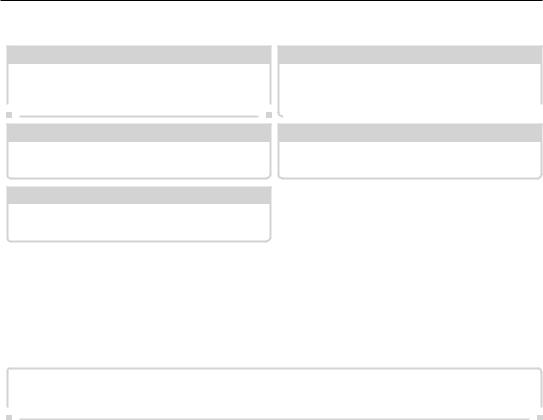
 About This Manual
About This Manual
Before using the camera, read this manual and the warnings in“For Your Safety”(Pii). For information on specific topics, consult the sources below.
Table of Contents ................................................... Px
The “Table of Contents” gives an overview of the entire manual. The principal camera operations are listed here.
Warning Messages and Displays ......................... |
P109 |
Find out what’s behind that flashing icon or error message in the display.
Restrictions on Camera Settings.......................... |
P119 |
See page 119 for restrictions on the options available in each shooting mode.
Troubleshooting ................................................ |
P105 |
Having a specific problem with the camera? Find the answer here.
|
|
|
............................................................Glossary |
P112 |
|
The meanings of some technical terms may be found here.
 Memory Cards
Memory Cards
Pictures are stored on optional SD, SDHC, and SDXC memory cards (P14), referred to in this manual as“memory cards.”
viii

 Product Care
Product Care
Camera body: For continued enjoyment of your camera, use a soft, dry cloth to clean the camera body after each use. Do not use alcohol, thinner, or other volatile chemicals, which could discolor or deform the leather on the camera body. Any liquid on the camera should be removed immediately with a soft, dry cloth. Use a blower to remove dust from the monitor, taking care to avoid scratches, and then gently wipe with a soft, dry cloth. Any remaining stains can be removed by wiping gently with a piece of FUJIFILM lens-cleaning paper to which a small amount of lens-cleaning fluid has been applied. To prevent dust entering the camera, replace the body cap when no lens is in place.
Image sensor: Dust can be removed from the image sensor using the VSENSOR CLEANING option in the setup menu (P85).
Interchangeable lenses: Use a blower to remove dust, then gently wipe with a soft, dry cloth. Any remaining stains can be removed by wiping gently with a piece of FUJIFILM lens-cleaning paper to which a small amount of lens-cleaning fluid has been applied. Replace the front and rear caps when the lens is not use.
ix

 Table of Contents
Table of Contents
For Your Safety..................................................................................... |
ii |
IMPORTANT SAFETY INSTRUCTIONS......................................... |
ii |
Safety Notes....................................................................................... |
iii |
NOTICES.............................................................................................. |
vii |
About This Manual.......................................................................... |
viii |
Product Care ........................................................................................ |
ix |
Before You Begin |
|
Symbols and Conventions.............................................................. |
1 |
Supplied Accessories ........................................................................ |
1 |
Parts of the Camera........................................................................... |
2 |
The Selector ........................................................................................ |
4 |
The Command Dial .......................................................................... |
4 |
Camera Displays................................................................................ |
5 |
Shooting: Viewfinder/LCD Monitor ........................................ |
5 |
Shooting: LCD Monitor................................................................ |
6 |
Playback: Viewfinder/LCD Monitor ......................................... |
6 |
First Steps |
|
Attaching the Strap ........................................................................... |
7 |
Attaching a Lens ................................................................................. |
9 |
Charging the Battery ..................................................................... |
10 |
Inserting the Battery and a Memory Card........................... |
11 |
Compatible Memory Cards..................................................... |
14 |
Turning the Camera on and Off ................................................ |
15 |
Basic Setup ......................................................................................... |
16 |
Choosing a Display ......................................................................... |
17 |
Focusing the Viewfinder ............................................................. |
18 |
Adjusting Display Brightness .................................................... |
18 |
The DISP/BACK Button....................................................................... |
19 |
Viewfinder: Shooting................................................................. |
19 |
LCD Monitor: Shooting............................................................. |
19 |
Viewfinder/LCD Monitor: Playback...................................... |
20 |
Basic Photography and Playback |
|
Taking Photographs....................................................................... |
21 |
Viewing Pictures .............................................................................. |
23 |
Viewing Pictures Full Frame....................................................... |
23 |
Viewing Photo Information ....................................................... |
24 |
Playback Zoom ............................................................................... |
24 |
Multi-Frame Playback................................................................... |
25 |
Deleting Pictures ............................................................................. |
26 |
Using the Flash ................................................................................. |
27 |
Macro Mode (Close-ups) .............................................................. |
29 |
Basic Movie Recording and Playback |
|
Recording High-Definition (HD) Movies............................... |
30 |
Viewing Movies ................................................................................ |
31 |
The Q (Quick Menu) Button |
|
x

Table of Contents
More on Photography and Playback |
|
Choosing an Exposure Mode..................................................... |
33 |
Program AE (P) ................................................................................ |
33 |
Shutter-Priority AE (S) .................................................................. |
34 |
Aperture-Priority AE (A)............................................................... |
35 |
Manual Exposure (M).................................................................... |
36 |
Long Time-Exposures (T/B)......................................................... |
37 |
Time (T).............................................................................................. |
37 |
Bulb (B)............................................................................................... |
37 |
Using a Remote Release.............................................................. |
38 |
White Balance ................................................................................... |
39 |
Sensitivity ........................................................................................... |
41 |
Focus Mode ........................................................................................ |
42 |
Focus Frame Selection................................................................. |
44 |
Focus/Exposure Lock ..................................................................... |
45 |
Exposure Compensation.............................................................. |
47 |
Metering .............................................................................................. |
48 |
Using the Self-Timer....................................................................... |
49 |
Film Simulation ................................................................................ |
51 |
Bracketing........................................................................................... |
52 |
Multiple Exposures......................................................................... |
53 |
Continuous Shooting (Burst Mode)........................................ |
54 |
Viewing Pictures Taken in a Single Burst .............................. |
55 |
Panoramas.......................................................................................... |
56 |
Viewing Panoramas ...................................................................... |
58 |
Recording Pictures in RAW Format ......................................... |
59 |
Creating JPEG Copies of RAW Pictures.................................. |
60 |
Using a Mount Adapter ................................................................ |
61 |
Mount Adapter Settings.............................................................. |
61 |
Choosing a Focal Length ......................................................... |
61 |
Distortion Correction ................................................................ |
61 |
Color Shading Correction........................................................ |
62 |
Peripheral Illumination Correction ...................................... |
62 |
Image Search..................................................................................... |
63 |
PhotoBook Assist............................................................................. |
64 |
Creating a PhotoBook.................................................................. |
64 |
Viewing Photobooks .................................................................... |
65 |
Editing and Deleting Photobooks........................................... |
65 |
The Fn Button.................................................................................... |
66 |
Saving Settings................................................................................. |
67 |
Advanced Movie Recording ....................................................... |
68 |
Depth of Field.................................................................................. |
68 |
Before Recording ........................................................................... |
68 |
Using an External Microphone................................................. |
68 |
xi

Table of Contents
Menus |
|
|
...................................................................................LIS MODE |
73 |
Using the Menus: Shooting Mode........................................... |
69 |
..........................................................................pFLASH MODE |
74 |
|
Shooting Menu Options (Photographs) ............................... |
69 |
IFLASH........................................................................................ |
74 |
|
NISO .............................................................................................. |
69 |
BRED EYE REMOVAL............................................................... |
74 |
|
OIMAGE SIZE.............................................................................. |
69 |
nSAVE ORG IMAGE.................................................................. |
74 |
|
TIMAGE QUALITY .................................................................... |
69 |
Shooting Menu Options (Movie Mode)................................ |
75 |
|
UDYNAMIC RANGE.................................................................. |
70 |
WMOVIE MODE ......................................................................... |
75 |
|
PFILM SIMULATION ................................................................ |
70 |
PFILM SIMULATION ................................................................ |
75 |
|
XFILM SIMULATION BKT ....................................................... |
70 |
DWHITE BALANCE ................................................................... |
75 |
|
BSELF-TIMER.............................................................................. |
70 |
tMIC LEVEL ADJUSTMENT .................................................. |
75 |
|
DWHITE BALANCE ................................................................... |
70 |
uMIC/REMOTE RELEASE........................................................ |
75 |
|
fCOLOR....................................................................................... |
70 |
vDISP. CUSTOM SETTING ..................................................... |
75 |
|
qSHARPNESS............................................................................. |
70 |
LIS MODE ................................................................................... |
75 |
|
rHIGHLIGHT TONE.................................................................. |
70 |
Using the Menus: Playback Mode............................................ |
76 |
|
sSHADOW TONE ..................................................................... |
70 |
Playback Menu Options .............................................................. |
76 |
|
hNOISE REDUCTION............................................................... |
71 |
jRAW CONVERSION............................................................... |
76 |
|
KLONG EXPOSURE NR ........................................................... |
71 |
AERASE ........................................................................................ |
76 |
|
uSELECT CUSTOM SETTING ................................................ |
71 |
GCROP.......................................................................................... |
77 |
|
KEDIT/SAVE CUSTOM SETTING.......................................... |
71 |
eRESIZE ....................................................................................... |
77 |
|
FFn BUTTON.............................................................................. |
71 |
DPROTECT .................................................................................. |
78 |
|
vDISP. CUSTOM SETTING ..................................................... |
71 |
CIMAGE ROTATE....................................................................... |
78 |
|
cFRAMING GUIDLINE ............................................................ |
72 |
BRED EYE REMOVAL............................................................... |
79 |
|
lMOUNT ADAPTOR SETTING............................................. |
72 |
ISLIDE SHOW ........................................................................... |
79 |
|
mSHOOT WITHOUT LENS...................................................... |
72 |
mPHOTOBOOK ASSIST ........................................................... |
80 |
|
nMULTIPLE EXPOSURE .......................................................... |
72 |
jMARK FOR UPLOAD TO ...................................................... |
80 |
|
FAF MODE.................................................................................. |
72 |
bIMAGE SEARCH...................................................................... |
80 |
|
CAF ILLUMINATOR .................................................................. |
73 |
KPRINT ORDER (DPOF).......................................................... |
81 |
|
kAE/AF-LOCK MODE.............................................................. |
73 |
JDISP ASPECT........................................................................... |
81 |
|
vAE/AF-LOCK BUTTON.......................................................... |
73 |
IPLAYBACK VOLUME............................................................. |
81 |
|
mAUTOROTATE PB ................................................................... |
73 |
|
|
|
xii

Table of Contents
The Setup Menu............................................................................... |
82 |
Using the Setup Menu................................................................. |
82 |
Setup Menu Options .................................................................... |
83 |
FDATE/TIME............................................................................... |
83 |
NTIME DIFFERENCE................................................................. |
83 |
La................................................................................ |
83 |
RRESET......................................................................................... |
83 |
oSILENT MODE......................................................................... |
83 |
BFRAME NO. .............................................................................. |
84 |
IFOCUS RING............................................................................ |
84 |
JEVF/LCD BRIGHTNESS......................................................... |
84 |
HQUICK START MODE............................................................ |
84 |
MAUTO POWER OFF................................................................ |
85 |
GOPERATION VOL.................................................................... |
85 |
AIMAGE DISP.............................................................................. |
85 |
VSENSOR CLEANING.............................................................. |
85 |
JCOLOR SPACE......................................................................... |
86 |
cGUIDANCE DISPLAY............................................................. |
86 |
MFOCUS SCALE UNITS ........................................................... |
86 |
OBACKGROUND COLOR........................................................ |
86 |
KFORMAT.................................................................................... |
86 |
Connections |
|
Viewing Pictures on a Computer.............................................. |
87 |
Windows: Installing MyFinePix Studio .................................. |
87 |
Macintosh: Installing FinePixViewer....................................... |
89 |
Connecting the Camera.............................................................. |
91 |
Printing Pictures via USB ............................................................. |
93 |
Connecting the Camera.............................................................. |
93 |
Printing Selected Pictures .......................................................... |
93 |
Printing the DPOF Print Order .................................................. |
94 |
Creating a DPOF Print Order...................................................... |
95 |
WITH DATE s/WITHOUT DATE ............................................ |
96 |
RESET ALL....................................................................................... |
97 |
Viewing Pictures on TV ................................................................. |
98 |
xiii

Table of Contents
Technical Notes |
|
Optional Accessories...................................................................... |
99 |
Accessories from FUJIFILM......................................................... |
99 |
Connecting the Camera to Other Devices......................... |
102 |
Caring for the Camera ................................................................. |
103 |
Storage and Use ........................................................................... |
103 |
Traveling.......................................................................................... |
103 |
Cleaning the Image Sensor....................................................... |
104 |
Troubleshooting |
|
Problems and Solutions ............................................................. |
105 |
Warning Messages and Displays............................................ |
109 |
Appendix |
|
Glossary ............................................................................................. |
112 |
Memory Card Capacity ............................................................... |
113 |
Specifications .................................................................................. |
114 |
Restrictions on Camera Settings............................................ |
119 |
xiv
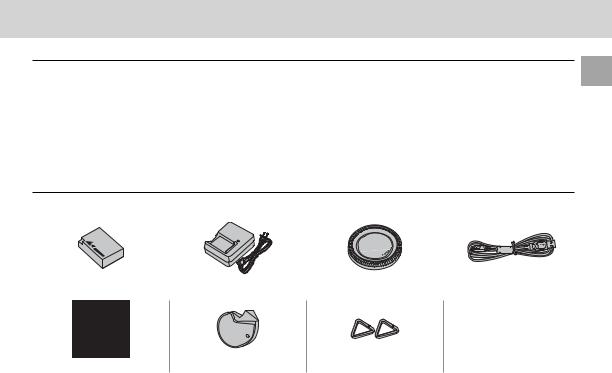
Before You Begin
 Symbols and Conventions
Symbols and Conventions
The following symbols are used in this manual:
QThis information should be read before use to ensure correct operation.
RAdditional information that may be helpful when using the camera.
POther pages in this manual on which related information may be found.
Menus and other text in the displays are shown in bold. In the illustrations in this manual, displays may be simplified for explanatory purposes.
 Supplied Accessories
Supplied Accessories
The following items are included with the camera:
Begin You Before
|
|
|
|
|
|
|
|
|
|
|
|
NP-W126 rechargeable battery |
BC-W126 battery charger |
Body cap |
|
USB cable |
|
|
|
|
|
|
|
• Owner’s Manual (this manual)
• Shoulder strap
• Protective covers (× 2)
CD-ROM |
Clip attaching tool |
Metal strap clips (× 2) |
1
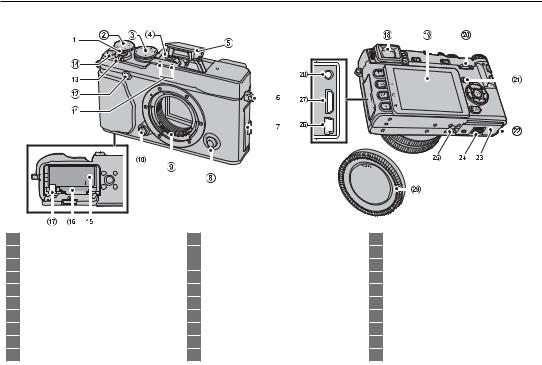
 Parts of the Camera
Parts of the Camera
For more information, refer to the page listed to the right of each item.
1 |
|
|
|
|
|
|
|
|
|
|
|
|
|
|
|
|
|
|
|
|
|
|
|
|
|
|
|
|
11 |
|
|
|
|
|
|
|
|
|
|
|
20 |
|
|
|
|
|
|
|
|
|
|
|
|
|
|
|
|
|
|
|
|
|
|
|
|
|
|
|
|
|
|
|
|
|
|
|
|
|
|
|
|
|
|
|
|
|
|
|
|
|
|
|
|
|
|
|
|
|
|||
|
|
|
|
|
|
|
|
|
|
|
|
|
|
|
|
|
|
|
|
|
|
|
|
|
|
|
|
|
|
|
|
|
|
|
|
|
|
|
|
|
|
|
|
|
|
|
|
|||
|
|
|
|
|
|
|
|
|
|
|
|
|
|
|
|
|
|
|
|
|
|
|
|
|
|
|
|
|
|
|
|
|
|
|
|
|
|
|
|
|
|
|
|
|
|
|
|
|||
|
|
|
|
|
|
|
|
|
|
|
|
|
|
|
|
|
|
|
|
|
|
|
|
|
|
|
|
|
|
|
|
|
|
|
|
|
|
|
|
|
|
|
|
|
|
|
|
|||
|
|
|
|
|
|
|
|
|
|
|
|
|
|
|
|
|
|
|
|
|
|
|
|
|
|
|
|
|
|
|
|
|
|
|
|
|
|
|
|
|
|
|
|
|
|
|
|
|||
|
|
|
|
|
|
|
|
|
|
|
|
|
|
|
|
|
|
|
|
|
|
|
|
|
|
|
|
|
|
|
|
|
|
|
|
|
|
|
|
|
|
|
|
|
|
|
|
|||
|
|
|
|
|
|
|
|
|
|
|
|
|
|
|
|
|
|
|
|
|
|
|
|
|
|
|
|
|
|
|
|
|
|
|
|
|
|
|
|
|
|
|
|
|
|
|
|
|||
|
|
|
|
|
|
|
|
|
|
|
|
|
|
|
|
|
|
|
|
|
|
|
|
|
|
|
|
|
|
|
|
|
|
|
|
|
|
|
|
|
|
|
|
|
|
|
|
|||
|
|
|
|
|
|
|
|
|
|
|
|
|
|
|
|
|
|
|
|
|
|
|
|
|
|
|
|
|
|
|
|
|
|
|
|
|
|
|
|
|
|
|
|
|
|
|
|
|||
|
|
|
|
|
|
|
|
|
|
|
|
|
|
|
|
|
|
|
|
|
|
|
|
|
|
|
|
|
|
|
|
|
|
|
|
|
|
|
|
|
|
|
|
|
|
|
|
|||
|
|
|
|
|
|
|
|
|
|
|
|
|
|
|
|
|
|
|
|
|
|
|
|
|
|
|
|
|
|
|
|
|
|
|
|
|
|
|
|
|
|
|
|
|
|
|
|
|||
|
|
|
|
|
|
|
|
|
|
|
|
|
|
|
|
|
|
|
|
|
|
|
|
|
|
|
|
|
|
|
|
|
|
|
|
|
|
|
|
|
|
|
|
|
|
|
|
|||
|
|
|
|
|
|
|
|
|
|
|
|
|
|
|
|
|
|
|
|
|
|
|
|
|
|
|
|
|
|
|
|
|
|
|
|
|
|
|
|
|
|
|
|
|
|
|
|
|||
................................................Shutter button |
22 |
.....................................................Microphone |
30 |
...................................................Command dial |
4 |
|||||||||||||||||||||||||||||||||||||||||||||
2 |
Exposure compensation dial |
........................... 47 |
12 |
AF-assist illuminator ....................................... |
73 |
21 |
Speaker........................................................... |
31 |
||||||||||||||||||||||||||||||||||||||||||
3 |
Shutter speed dial.......................... |
33, 34, 35, 36 |
|
Self-timer lamp............................................... |
49 |
22 |
Cable channel cover for DC coupler |
|
|
|||||||||||||||||||||||||||||||||||||||||
4 |
Hot shoe................................................... |
28, 102 |
13 |
ON/OFF switch ............................................... |
15 |
23 |
Battery-chamber cover ................................... |
11 |
||||||||||||||||||||||||||||||||||||||||||
5 |
Flash ............................................................... |
27 |
14 |
Fn (Function) button ...................................... |
66 |
24 |
Battery-chamber cover latch........................... |
11 |
||||||||||||||||||||||||||||||||||||||||||
6 |
Strap eyelet....................................................... |
7 |
15 |
Battery chamber ............................................. |
11 |
25 |
Tripod mount |
|
|
|||||||||||||||||||||||||||||||||||||||||
7 |
Connector cover ....................... |
38, 68, 91, 93, 98 |
16 |
Memory card slot ............................................ |
12 |
26 |
USB mini connector.............................. |
38, 91, 93 |
||||||||||||||||||||||||||||||||||||||||||
8 |
Focus mode selector................................... |
21, 42 |
17 |
Battery latch ................................................... |
11 |
27 |
HDMI mini connector ...................................... |
98 |
||||||||||||||||||||||||||||||||||||||||||
9 |
Lens signal contacts |
|
|
|
|
|
|
|
|
|
|
18 |
Electronic viewfi nder (EVF) ............................. |
17 |
28 |
Microphone/remote release connector |
......38, 68 |
|||||||||||||||||||||||||||||||||
10 |
Lens release button........................................... |
9 |
19 |
LCD monitor .................................................... |
17 |
29 Body cap ........................................................... |
9 |
|||||||||||||||||||||||||||||||||||||||||||
2
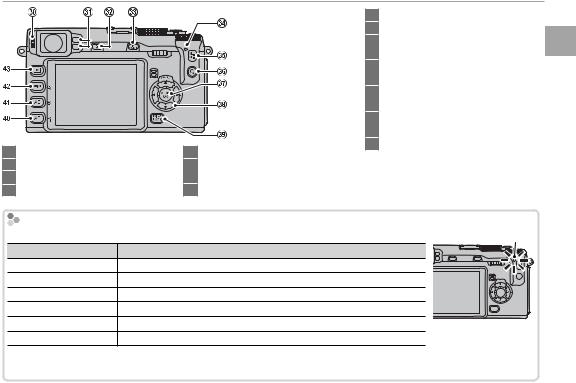
Parts of the Camera
37 |
MENU/OK button ............................................. |
4 |
38 |
Selector............................................................. |
4 |
39 |
DISP (display)/BACK button........................... |
19 |
|
o(silent mode) button .................................. |
4 |
40 |
AF (autofocus) button..................................... |
44 |
|
b(delete) button .......................................... |
26 |
41 |
AE (autoexposure) button............................... |
48 |
|
n(playback zoom out) button................. |
24, 25 |
42 |
DRIVE button ................................ |
30, 52, 54, 56 |
|
k(playback zoom in) button ................... |
24, 25 |
43 |
a(playback) button..................................... |
23 |
30 |
Diopter adjustment control............................. |
18 |
34 |
Indicator lamp (see below) |
|
31 |
Eye sensor ....................................................... |
17 |
35 |
AE-L/AF-L (exposure/focus lock) button |
|
32 |
N(fl ash pop-up) button................................. |
27 |
36 |
Q.............................................................(quick menu) button |
42, 45, 73 |
33 |
VIEW MODE button........................................ |
17 |
32 |
||
The Indicator Lamp |
|
|
The indicator lamp shows camera status as follows: |
Indicator lamp |
|
Indicator lamp |
Camera status |
|
Glows green |
Focus locked. |
|
Blinks green |
Blur, focus, or exposure warning. Picture can be taken. |
|
Blinks green and orange |
Recording pictures. Additional pictures can be taken. |
|
Glows orange |
Recording pictures. No additional pictures can be taken at this time. |
|
Blinks orange |
Flash charging; flash will not fire when picture is taken. |
|
Blinks red |
Lens or memory error. |
|
R Warnings may also appear in the display (P109).
R The indicator lamp remains off while the viewfinder is in use (P17).
Begin You Before
3
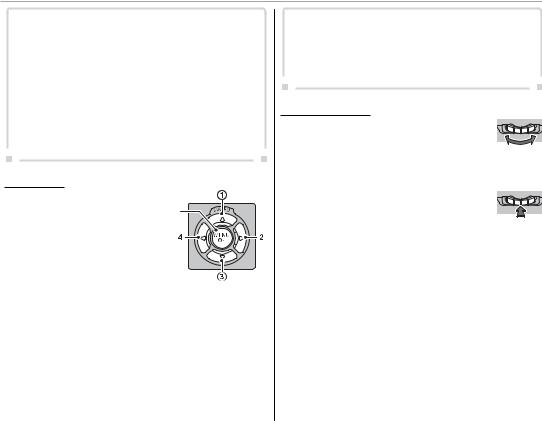
Parts of the Camera
 Silent Mode
Silent Mode
In situations in which camera sounds or lights may be unwelcome, press the DISP/BACK button until the o icon is displayed (about a second). The camera speaker, flash, and AF-assist illuminator/self-timer lamp turn off and flash and volume settings can not be adjusted (note that silent mode can not be enabled or disabled while movie playback is in progress). Press the DISP/BACK button again to resume normal operation.
The Selector
Press the selector up (q), right (w), down (e), or left (r) to  highlight items and press MENU/ OK (t) to select. Pressing the selector up (MACRO) during shooting displays macro options (P29).
highlight items and press MENU/ OK (t) to select. Pressing the selector up (MACRO) during shooting displays macro options (P29).
 Control Lock
Control Lock
To avoid accidentally displaying macro options during shooting, press MENU/OK until Xis displayed. The control can be unlocked by pressing MENU/OK until X is no longer displayed.
The Command Dial
The command dial can be used to navigate the menus, to view pictures (P23), and to select options in the quick menu display (P32).
Press the center of the command dial to zoom in on the focus area selected for manual focus (P43) or the active focus point during playback (P24).
4
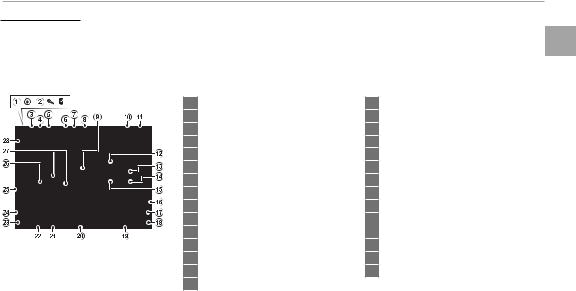
Parts of the Camera
Camera Displays
The following types of indicator may be displayed during shooting and playback. In the description that follows, all available indicators are shown for illustrative purposes; the indicators actually displayed vary with camera settings.
■ Shooting: Viewfinder/LCD Monitor
|
|
|
|
|
|
|
100 |
F |
0.1 |
0.5 |
1.0 |
1.5 |
2.0 |
3.0 |
5.0 |
10 |
|
P |
2000 |
F5.6 |
|
200 |
|
|||
1 |
Flash mode ..................................................... |
27 |
16 |
2 |
Microphone/remote release................. |
38, 68, 75 |
17 |
3 |
Macro (close-up) mode ................................... |
29 |
18 |
4 |
Self-timer indicator......................................... |
49 |
19 |
5 |
Continuous mode............................................ |
54 |
20 |
6 |
White balance................................................. |
39 |
21 |
7 |
Film simulation ............................................... |
51 |
22 |
8 |
Dynamic range................................................ |
70 |
23 |
9 |
Focus frame................................................ |
22, 45 |
24 |
10 |
Number of available frames .......................... |
113 |
25 |
11 |
Image quality and size .................................... |
69 |
26 |
12 |
Temperature warning.................................... |
111 |
|
13 |
Blur warning ...................................... |
3, 107, 109 |
27 |
14 |
IS Mode........................................................... |
73 |
28 |
15 |
Focus warning.................................... |
3, 107, 109 |
|
Silent mode indicator................................... |
4, 83 |
Distance indicator ........................................... |
42 |
Battery level.................................................... |
15 |
Sensitivity ....................................................... |
41 |
Aperture......................................... |
33, 35, 36, 68 |
Shutter speed....................................... |
33, 34, 36 |
Metering ......................................................... |
48 |
Shooting mode ............................................... |
33 |
Manual focus indicator.................................... |
42 |
Exposure compensation/ |
|
exposure indicator...................................... |
36, 47 |
Histogram ....................................................... |
20 |
Virtual horizon ................................................ |
71 |
Depth-of-fi eld preview ................................... |
35 |
Begin You Before
5
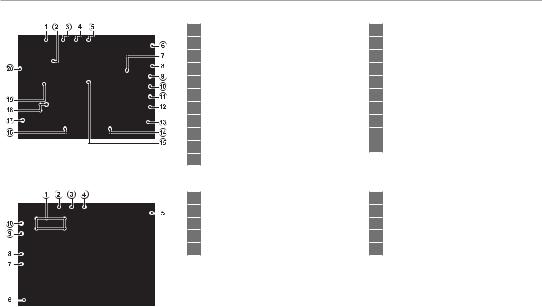
Parts of the Camera
■ Shooting: LCD Monitor
000100 |
F |
P 1 2000 |
F5.6 |
200 |
1 |
Flash mode ..................................................... |
27 |
12 |
Battery level.................................................... |
15 |
2 |
Macro (close-up) mode ................................... |
29 |
13 |
Sensitivity ....................................................... |
41 |
3 |
Metering ......................................................... |
48 |
14 |
Aperture......................................... |
33, 35, 36, 68 |
4 |
Continuous mode............................................ |
54 |
15 |
Focus frame/focus point.................................. |
44 |
5 |
Silent mode indicator................................... |
4, 83 |
16 |
Shutter speed....................................... |
33, 34, 36 |
6 |
Number of available frames .......................... |
113 |
17 |
Shooting mode ............................................... |
33 |
7 |
Temperature warning.................................... |
111 |
18 |
Focus mode..................................................... |
42 |
8 |
Image quality and size .................................... |
69 |
19 |
Self-timer indicator......................................... |
49 |
9 |
Dynamic range................................................ |
70 |
20 |
Exposure compensation/ |
|
10 |
Film simulation ............................................... |
51 |
|
exposure indicator...................................... |
36, 47 |
11 |
White balance................................................. |
39 |
|
|
|
■ Playback: Viewfinder/LCD Monitor
|
1 |
Rating ............................................................. |
23 |
6 |
Playback mode indicator................................. |
23 |
||
100-0001 |
|
2 |
Red-eye removal indicator .............................. |
79 |
7 |
Mark for upload to .......................................... |
80 |
|
3 |
Silent mode indicator |
4, 83 |
8 |
Photobook assist indicator |
64 |
|||
|
||||||||
YouTube |
3:2 F |
4 |
Gift image ....................................................... |
23 |
9 |
DPOF print indicator........................................ |
95 |
|
5 |
Frame number ................................................ |
84 |
10 |
Protected image.............................................. |
78 |
12 / 31 / 2050 |
10:00 |
AM |
|
|
|
|
|
|
|
2 |
|
|
1 / 1000 |
F4.5 |
-1 |
/3 |
200 |
6
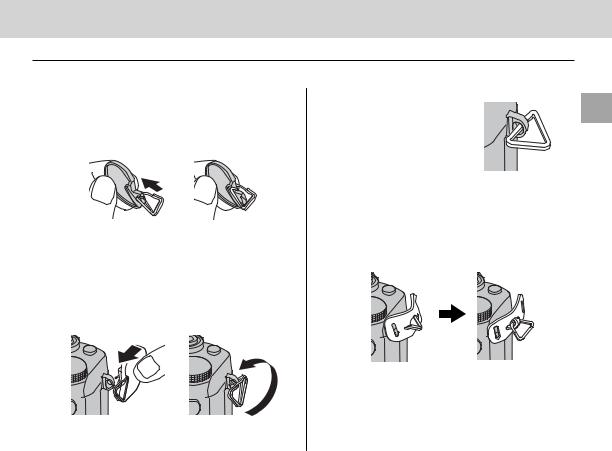
First Steps
 Attaching the Strap
Attaching the Strap
Attach the strap clips to the camera and then attach the strap.
1Open a strap clip.
Use the clip attaching tool to open a strap clip, making sure that the tool and clip are in the orientations shown.
QKeep the tool in a safe place. You will need it to open the strap clips when removing the strap.
2Place the strap clip on an eyelet.
Hook the strap eyelet in the clip opening. Remove the tool, using the other hand to keep the clip in place.
3Pass the clip through the eyelet.
Rotate the clip fully through 
the eyelet until it clicks closed.
4Attach a protective cover.
Place a protective cover over the eyelet as shown, with the black side of the cover toward the camera. Repeat Steps 1–4 for the second eyelet.
Steps First
7
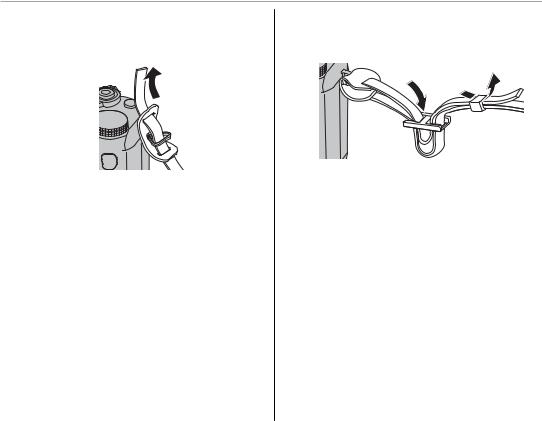
Attaching the Strap
5Insert the strap.
Insert the strap through a protective cover and strap clip.
6Fasten the strap.
Fasten the strap as shown. Repeat Steps 5–6 for the second eyelet.
Q To avoid dropping the camera, be sure the strap is correctly secured.
8
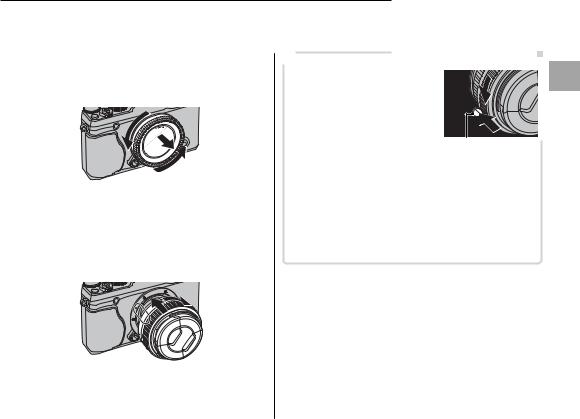
 Attaching a Lens
Attaching a Lens
Lenses attach as described below.
Q Care is required to prevent dust entering the camera while attaching and removing lenses.
1Remove the body and rear caps.
Remove the body cap from the camera and the rear cap from the lens.
Q Do not touch the camera’s internal parts.
2Attach the lens.
Place the lens on mount, keeping the marks on the lens and camera aligned, and then rotate the lens until it clicks into place.
 Removing Lenses
Removing Lenses
To remove the lens, turn the camera off, then press the lens release button and rotate the lens as shown.
Lens release button
QTo prevent dust accumulating on the lens or inside the camera, replace the lens caps and camera body cap when the lens is not attached.
 Lenses and Other Optional Accessories
Lenses and Other Optional Accessories
The camera can be used with lenses for the FUJIFILM X-mount and the other accessories listed from page 99.
Q Do not press the lens release button while attaching the lens.
Steps First
9
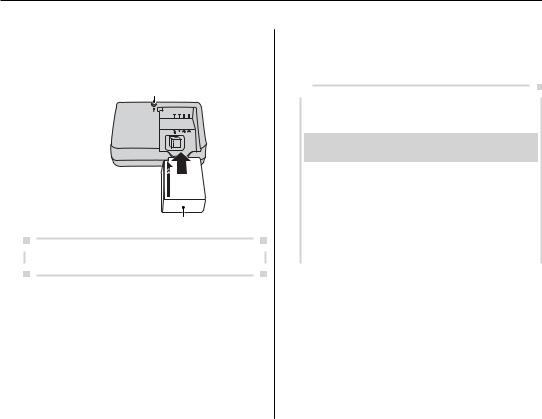
 Charging the Battery
Charging the Battery
The battery is not charged at shipment. Charge the battery before use.
1Place the battery in the charger.
Place the battery in the supplied battery charger as shown.
Charge lamp
Battery charger
Arrow
Battery
The camera uses an NP-W126 rechargeable battery.
2Plug the charger in.
Plug the charger into a power outlet. The charging indicator will light.
 The Charging Indicator
The Charging Indicator
The charging indicator shows battery charge status as follows:
|
|
Charging |
Battery status |
Action |
|
|
|
|
indicator |
|
|||
|
|
|
|
|
|
|
|
|
|
Battery not |
Insert the battery. |
|
|
|
|
|
inserted. |
|
||
|
|
Off |
|
|
|
|
|
|
|
|
|
|
|
|
|
Battery fully |
Remove the battery. |
|
||
|
|
|
|
|||
|
|
|
charged. |
|
||
|
|
|
|
|
|
|
|
|
On |
Battery charging. |
— |
|
|
|
|
|
|
|
|
|
|
|
|
|
Unplug the charger |
|
|
|
|
Blinks |
Battery fault. |
and remove the |
|
|
|
|
|
|
battery. |
|
|
|
|
|
|
|
|
|
|
|
|
|
|
|
|
|
|
|
|
|
|
|
3Charge the battery.
Remove the battery when charging is complete. See the specifications (P117) for charging times (note that charging times increase at low temperatures).
Q Unplug the charger when it is not in use.
10
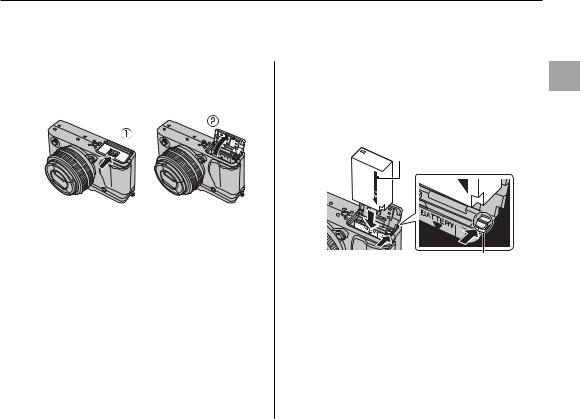
 Inserting the Battery and a Memory Card
Inserting the Battery and a Memory Card
The camera has no internal memory; instead, pictures are stored on optional SD, SDHC, and SDXC memory cards (sold separately). After charging the battery, insert the battery and memory card as described below.
1Open the battery-chamber cover.
Slide the battery-chamber latch as shown and open the battery-chamber cover.
QDo not open the battery-chamber cover when the camera is on. Failure to observe this precaution could damage image files or memory cards.
Q Do not use excessive force when handling the battery-chamber cover.
2Insert the battery.
Using the battery to keep the battery latch pressed to one side, insert the battery contacts first in the direction shown by the arrow. Confirm that the battery is securely latched.
Arrow
Battery latch
Q Insert the battery in the correct orientation. Do not use force or attempt to insert the battery upside down or backwards. The battery will slide in easily in the correct orientation.
Steps First
11
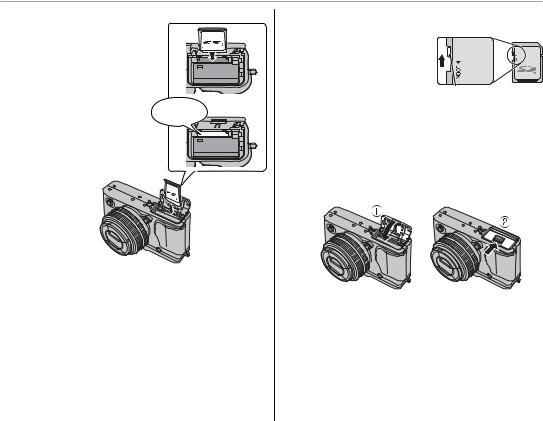
Inserting the Battery and a Memory Card
3 Insert the memory card.
Holding the memory card in the orientation
shown at |
right, slide |
it in until it clicks into |
|
place at the back of |
|
the slot. |
Click |
Q Be sure card is in the correct orientation; do not insert at an angle or use force.
Q SD/SDHC/SDXC memory cards can be locked,
making it impossible to
format the card or to Write-protect switch record or delete images.
Before inserting a memory card, slide the writeprotect switch to the unlocked position.
4Close the battery-chamber cover.
Slide the battery-chamber latch as shown and close the battery-chamber cover.
12
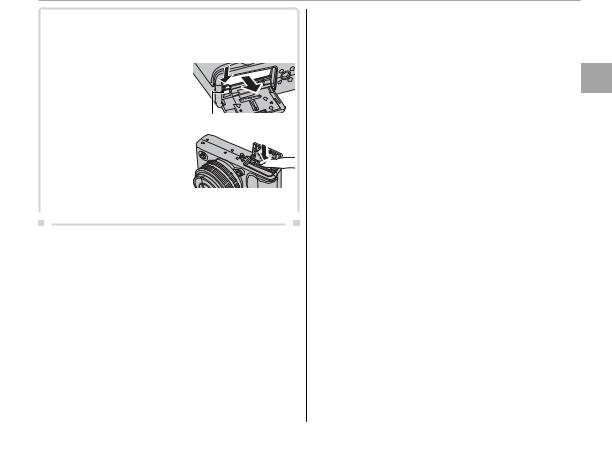
Inserting the Battery and a Memory Card
 Removing the Battery and Memory Card
Removing the Battery and Memory Card
Before removing the battery or memory card, turn the camera off and open the battery-chamber cover.
To remove the battery, press the battery latch to the side, and slide the battery out of
the camera as shown.
Battery latch
To remove the memory card,
press it in and release it slowly. The card can then be removed by hand. When a memory card
is removed, the card could be ejected too quickly. Use your finger to hold it and gently release the card.
Q Batteries
•Remove dirt from the battery terminals with a clean, dry cloth. Failure to observe this precaution could prevent the battery from charging.
•Do not affix stickers or other objects to the battery. Failure to observe this precaution could make it impossible to remove the battery from the camera.
•Do not short the battery terminals. The battery could overheat.
•Read the cautions in “The Battery and Power Supply” (Piv).
•Use only battery chargers designated for use with the battery. Failure to observe this precaution could result in product malfunction.
•Do not remove the labels from the battery or attempt to split or peel the outer casing.
•The battery gradually loses its charge when not in use. Charge the battery one or two days before use.
Steps First
13

Inserting the Battery and a Memory Card
■ Compatible Memory Cards
FUJIFILM and SanDisk SD, SDHC, and SDXC memory cards have been approved for use in the camera. A complete list of approved memory cards is available at http://www.fujifilm.com/support/digital_ cameras/compatibility/. Operation is not guaranteed with other cards. The camera can not be used with xD-Picture Cards or MultiMediaCard (MMC) devices.
Q Memory Cards
•Do not turn the camera off or remove the memory card while the memory card is being formatted or data are being recorded to or deleted from the card. Failure to observe this precaution could damage the card.
•Format memory cards before first use, and be sure to reformat all memory cards after using them in a computer or other device. For more information on formatting memory cards, see page 86.
•Memory cards are small and can be swallowed; keep out of reach of children. If a child swallows a memory card, seek medical assistance immediately.
•miniSD or microSD adapters that are larger or smaller than the standard dimensions of an SD/SDHC/SDXC card may not eject normally; if the card does not eject, take the camera to an authorized service representative. Do not forcibly remove the card.
•Do not affix labels to memory cards. Peeling labels can cause camera malfunction.
•Movie recording may be interrupted with some types of SD/SDHC/SDXC memory card. Use a Gcard or better when shooting HD movies.
•Formatting a memory card in the camera creates a folder in which pictures are stored. Do not rename or delete this folder or use a computer or other device to edit, delete, or rename image files. Always use the camera to delete pictures; before editing or renaming files, copy them to a computer and edit or rename the copies, not the originals. Renaming the files on the camera can cause problems during playback.
14
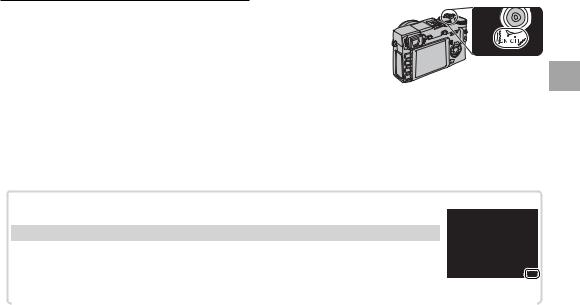
 Turning the Camera on and Off
Turning the Camera on and Off
Rotate the ON/OFF switch to ON to turn the camera on. Select OFF to turn the camera off.
R Press the a button to start playback. Press the shutter button halfway to return to shooting mode.
R The camera will turn off automatically if no operations are performed for the length of time selected for MAUTO POWER OFF (P85). To reactivate the
camera after it has turned off automatically, press the shutter button halfway or turn the ON/OFF switch to OFF and then back to ON.
R For information on startup options, see page 84.
QFingerprints and other marks on the lens or viewfinder can affect pictures or the view through the viewfinder. Keep the lens and viewfinder clean.
 Battery Level
Battery Level
After turning the camera on, check the battery level in the display.
Indicator |
Description |
|
D(white) |
Battery partially discharged. |
|
C(white) |
Battery more than half discharged |
|
|
|
|
B(red) |
Low battery. Charge as soon as possible. |
P |
|
|
|
|
|
|
A(blinks red) |
Battery exhausted. Turn camera off and recharge battery. |
|
|
|
|
Steps First
15

 Basic Setup
Basic Setup
A language-selection dialog is displayed the first time the camera is turned on. Set up the camera as described below (you can reset the clock or change languages at any time using the FDATE/ TIME or Laoptions in the setup menu; for information on displaying the setup menu, see page 83).
1 Choose a language.
Highlight a language and press MENU/OK.
ENGLISH |
|
R Press DISP/BACK to skip the current step. Any steps you skip will be dis- |
|
|
|
|
|
played the next time the camera is turned on. |
FRANCAIS |
|
|
DEUTSCH |
|
|
SET |
NO |
|
2 Set the date and time.
|
DATE/TIME NOT SET |
|
Press the selector left or right to highlight the year, month, day, hour, |
|
|
|
|
|
|
|
|
2014 |
|
or minute and press up or down to change. To change the order in |
|
|
2013 |
|
|
YY. MM. DD |
2012 |
1. 1 12:00 |
which the year, month, and day are displayed, highlight the date for- |
|
|
|
2011 |
AM |
|
|
|
2010 |
|
mat and press the selector up or down. Press MENU/OK to exit to shoot- |
|
SET |
NO |
|
|
|
|
|
||
ing mode when settings are complete.
RIf the battery is removed for an extended period, the camera clock will be reset and the language-selection dialog will be displayed when the camera is turned on.
16
